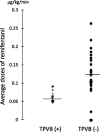Thoracic paravertebral block reduced the incidence of chronic postoperative pain for more than 1 year after breast cancer surgery
- PMID: 29497651
- PMCID: PMC5818708
- DOI: 10.1186/s40981-015-0023-4
Thoracic paravertebral block reduced the incidence of chronic postoperative pain for more than 1 year after breast cancer surgery
Abstract
Background: Thoracic paravertebral block (TPVB) is used to reduce pain after breast cancer surgery (BCS), but the pain-reduction effects more than 1 year after surgery are unclear.
Findings: Fifty-one patients underwent BCS at the Niigata City General Hospital from December 2009 through March 2010. To evaluate the long-term effects of TPVB in the reduction of chronic pain after BCS, we retrospectively reviewed the anesthesia charts and medical records of these patients and conducted telephone surveys regarding postoperative pain 13-17 months after surgery in 46 of these patients. Among the 46 patients enrolled in this study, 17 experienced chronic pain. There was a significant difference in the percentage of patients that received TPVB among those with and without chronic pain (patients with chronic pain 5/17 (29.4 %), patients without chronic pain 18/29 (62.1 %), p = 0.039). The pain score 3-6 h after surgery was significantly higher in the patients with chronic pain than without (p = 0.016). Bivariate logistic regression revealed that TPVB and pain score 3-6 h after surgery were independent predictive factors of chronic pain after BCS.
Conclusions: These results indicate that TPVB has the potential to reduce chronic pain for more than 1 year after BCS.
Keywords: Breast cancer surgery; Chronic postoperative pain; Thoracic paravertebral block.
Figures



Similar articles
-
Effect of thoracic paravertebral block on intraoperative hypotension and postoperative pain in patients undergoing breast cancer surgery under general anesthesia: a retrospective study.Ann Palliat Med. 2021 Aug;10(8):8930-8938. doi: 10.21037/apm-21-1803. Ann Palliat Med. 2021. PMID: 34488380
-
Impact of paravertebral blockade use in geriatric patients undergoing thoracic surgery on postoperative adverse outcomes.J Thorac Dis. 2019 Dec;11(12):5169-5176. doi: 10.21037/jtd.2019.12.13. J Thorac Dis. 2019. PMID: 32030234 Free PMC article.
-
Thoracic paravertebral block and its effects on chronic pain and health-related quality of life after modified radical mastectomy.Reg Anesth Pain Med. 2014 Jul-Aug;39(4):289-98. doi: 10.1097/AAP.0000000000000113. Reg Anesth Pain Med. 2014. PMID: 24956453 Clinical Trial.
-
Paravertebral anaesthesia with or without sedation versus general anaesthesia for women undergoing breast cancer surgery.Cochrane Database Syst Rev. 2021 Feb 25;2(2):CD012968. doi: 10.1002/14651858.CD012968.pub2. Cochrane Database Syst Rev. 2021. PMID: 33629404 Free PMC article.
-
Anesthesia and analgesia in breast surgery: the benefits of peripheral nerve block.Eur Rev Med Pharmacol Sci. 2017 Mar;21(6):1341-1345. Eur Rev Med Pharmacol Sci. 2017. PMID: 28387892 Review.
Cited by
-
Post-Mastectomy Pain: An Updated Overview on Risk Factors, Predictors, and Markers.Life (Basel). 2021 Sep 29;11(10):1026. doi: 10.3390/life11101026. Life (Basel). 2021. PMID: 34685397 Free PMC article. Review.
-
<Editors' Choice> Efficacy of pectoral nerve block type-2 (Pecs II block) versus serratus plane block for postoperative analgesia in breast cancer surgery: a retrospective study.Nagoya J Med Sci. 2020 Feb;82(1):93-99. doi: 10.18999/nagjms.82.1.93. Nagoya J Med Sci. 2020. PMID: 32273637 Free PMC article.
-
Evidence-Based Guideline on the Prevention and Management of Perioperative Pain for Breast Cancer Peoples in a Low-Resource Setting: A Systematic Review Article.Anesthesiol Res Pract. 2023 Nov 3;2023:5668399. doi: 10.1155/2023/5668399. eCollection 2023. Anesthesiol Res Pract. 2023. PMID: 37953883 Free PMC article. Review.
-
Thoracic Paravertebral Block with Adjuvant Dexmedetomidine in Video-Assisted Thoracoscopic Surgery: A Randomized, Double-Blind Study.J Clin Med. 2019 Mar 12;8(3):352. doi: 10.3390/jcm8030352. J Clin Med. 2019. PMID: 30871093 Free PMC article.
-
"Post Mastectomy Pain Syndrome: A Systematic Review of Prevention Modalities".JPRAS Open. 2021 Oct 30;31:32-49. doi: 10.1016/j.jpra.2021.10.009. eCollection 2022 Mar. JPRAS Open. 2021. PMID: 34926777 Free PMC article.
References
-
- International Agency for Research on Cancer WHO. CANCERMondial Lyon, France2010 [cited 2014 July 28]. Available from: http://www-dep.iarc.fr/.
-
- Group UCSW. United States Cancer Statistics: 1999–2010 incidence and mortality web-based report. 2013. Available from: www.cdc.gov/uscs.
-
- Fisher B, Anderson S, Bryant J, Margolese RG, Deutsch M, Fisher ER, Jeong JH, Wolmark N. Twenty-year follow-up of a randomized trial comparing total mastectomy, lumpectomy, and lumpectomy plus irradiation for the treatment of invasive breast cancer. N Engl J Med. 2002;347:1233–1241. doi: 10.1056/NEJMoa022152. - DOI - PubMed
-
- Krag DN, Anderson SJ, Julian TB, Brown AM, Harlow SP, Costantino JP, Ashikaga T, Weaver DL, Mamounas EP, Jalovec LM, Frazier TG, Noyes RD, Robidoux A, Scarth HM, Wolmark N. Sentinel-lymph-node resection compared with conventional axillary-lymph-node dissection in clinically node-negative patients with breast cancer: overall survival findings from the NSABP B-32 randomised phase 3 trial. Lancet Oncol. 2010;11:927–933. doi: 10.1016/S1470-2045(10)70207-2. - DOI - PMC - PubMed
LinkOut - more resources
Full Text Sources
Other Literature Sources
